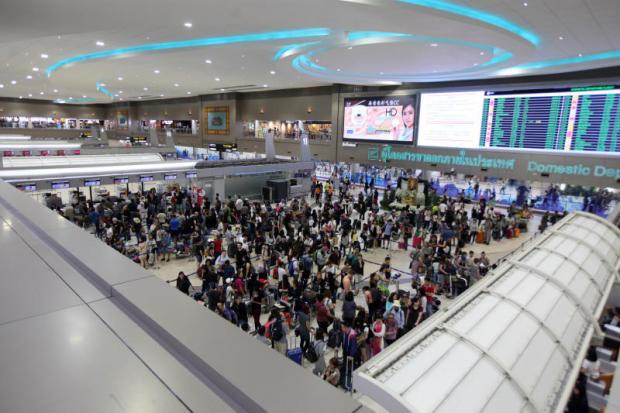
The combined capacity of airports under Airports of Thailand Plc's (AoT) supervision has fallen well short of actual utilisation, resulting in congestion, according to AoT data.
The data showed that while the six AoT-operated airports have a combined capacity to handle 96.6 million passengers a year, a total of 120 million passengers were processed in the fiscal year to Sept 30, 2016, 24.3% over.
All but one AoT airport is being run well beyond the designed capacity for passenger handling.
Chiang Rai airport is the only exception, even though passenger traffic through the facility has been on the rise, fuelled by holiday travel.
Airport with the most critical shortfalls in passenger handling capacities were, from highest to lowest, Suvarnabhumi, Phuket and Don Mueang.
With a 45-million-passenger-year designed capacity, Suvarnabhumi, Thailand's main gateway, processed 55.5 million in the 2016 fiscal year.
Phuket airport has a capacity of 8 million per year, but 14.7 million were crammed in the same fiscal year.
A total of 34.7 million passengers were squeezed through Don Mueang, dubbed as Southeast Asia's largest low-cost carrier hub, in the year, against the airport's 30-million designed capacity.
Chiang Mai handled 9.2 million passengers in the year compared to its capacity of 8 million a year.
Hat Yai is also facing similar situation, with 3.87 million passengers passing through it in the year, surpassing its capacity of 2.5 million.
Chiang Rai airport was the only airport that operated well below its 3-million capacity, with 1.96 million recorded in the year.
However, the AoT still has a little room in combined capacity to handle aircraft movements, indicated by 96.2% of total designed capacity being utilised in the year.
Specifically, the six airports are able together to handle 186 flights per hour, while actual utilisation for the year came with 179.
The overcrowding at those airports clearly reflects the AoT's reactive approach to capacity planning, marred by underestimations of traffic demand growth and bureaucracy.
Congestion will only worsen over the years to come as AoT continues to squeeze increasing numbers of passengers and flights into the crowded facilities, while not moving fast enough to add new airport capacities.
Rising congestion is clearly seen at Suvarnabhumi, Don Mueang and Phuket airports.
Suvarnabhumi airport expects passenger throughput for the fiscal year to Sept 30, 2017 to reach 59 million.
Indeed, Suvarnabhumi has lost a decade in starting a much-needed expansion.
The expansion of the airport, which includes the construction of a third runway and a second passenger terminal, together expects to cost over 110 billion baht, will not be entirely completed for next four years.
When the work is completed in 2021, Suvarnabhumi's annual passenger handling capacity will be raised to 90 million.
Don Mueang's next stage of works to increase the airport's annual passenger handling capacity to 40 million from 30 million is not expected to be operational before 2022.
The International Air Transport Association (IATA) has recently called on Thai authorities to expedite airport upgrades, especially Suvarnabhumi, to make sure they are able to cope with the soaring number of air travellers over the next 20 years.
After talks with IATA officials in Bangkok, Transport Minister Arkhom Termpittayapaisith admitted that progress on Suvarnabhumi's expansion has been " very slow," and would require "swift action".